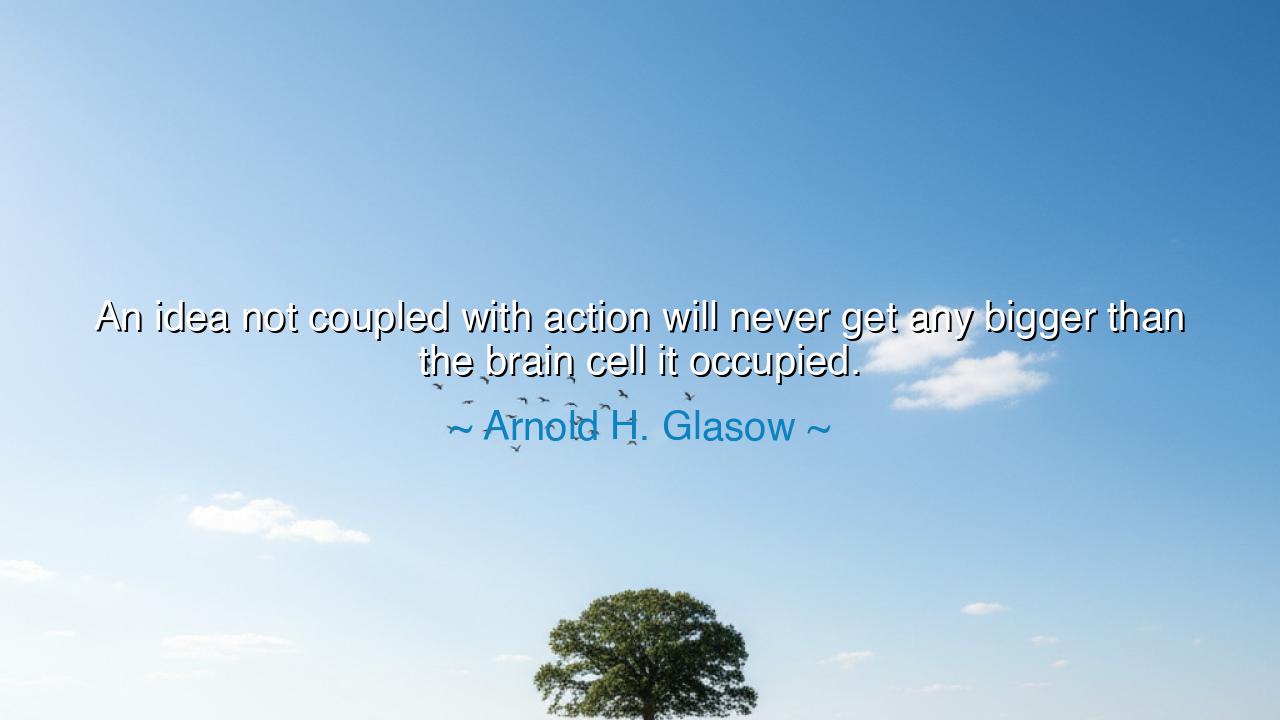
An idea not coupled with action will never get any bigger than
An idea not coupled with action will never get any bigger than the brain cell it occupied.






The words of Arnold H. Glasow ring with the urgency of truth: “An idea not coupled with action will never get any bigger than the brain cell it occupied.” In this saying lies the ancient struggle between thought and deed. A spark of vision, however brilliant, is but a fleeting shadow if it is not carried forth into the world. The mind may conceive wonders, but without hands to shape them and courage to pursue them, they wither unseen, no greater than whispers in the dark.
In the scrolls of time, countless souls have been filled with dreams that never crossed the threshold of action. The ancients knew this well, warning that wisdom without courage is barren, and imagination without labor is stillborn. An idea is a seed; only when it is planted, watered, and nurtured does it bear fruit. To hoard it within the mind is to bury treasure where no one may find it.
Consider the tale of Leonardo da Vinci. His notebooks brimmed with inventions—the helicopter, the tank, the flying machine—centuries ahead of his age. Yet many of his ideas never left parchment, bound forever in sketches. Though his genius dazzles us, we are reminded that the unbuilt marvel is a ghost, a vision trapped within a single brain cell. How much greater still might his legacy have been had more of his designs been forged into reality!
And yet, history also offers the opposite lesson: the power of thought joined with deed. Thomas Edison, holding fast to the vision of harnessing light, turned the fragile idea of the electric bulb into a reality that reshaped human civilization. His brilliance was not only in conceiving the thought, but in testing, failing, and persevering until his vision illuminated the world. In him, Glasow’s words find their triumph—proof that action gives breath and body to thought.
So let this teaching endure: an idea alone is a phantom, but an idea with action becomes a monument. Do not let the visions of your heart remain prisoners of the mind. Carry them into the world with labor and boldness, for only then will they grow, multiply, and outlast you. Thought without deed dies; but thought joined with deed becomes destiny.






GHNguyen Gia Huy
Glasow’s words challenge us to consider how we treat our ideas. It's easy to let a thought remain just that—a thought. But how do we take ideas to the next level? Do you think the fear of failure plays a large role in stalling action? And once we do take action, is it more about persistence over time, or do we need to be adaptable and learn as we go?
BTNGUYEN DAM BAO TRAM
This quote really speaks to the heart of productivity and creativity. Ideas are powerful, but without action, they’re like seeds that never sprout. How do we keep ourselves motivated to take action on our ideas? Do we need to create specific systems or routines to ensure that action happens, or is it more about the mindset we cultivate around our ideas?
TVthu vuong
Glasow's statement is a wake-up call about the importance of turning ideas into tangible actions. But I also wonder: Can an idea truly grow if it’s not nurtured, even with action? Does the type of action matter—are small, incremental steps just as effective as bold moves? How much of the process is about persistence versus brilliance in execution?
DNDuc Nguyen
I like how Glasow emphasizes the role of action in realizing potential. It reminds me of the concept that 'ideas are a dime a dozen.' Without execution, ideas remain just thoughts. I’m curious, how do we develop the discipline to act on our ideas consistently? And how do we find the right balance between planning and execution, without jumping in too hastily and making mistakes?
NHNguyen Hoat
This quote really hits home for me. How many times do we sit on brilliant ideas, only for them to fade away because we didn’t follow through? I wonder, why do so many people get stuck in the 'thinking' stage? Is it fear of failure, or lack of resources, or is it simply a matter of not knowing where to start? What’s your take—how do we bridge that gap between thought and action?